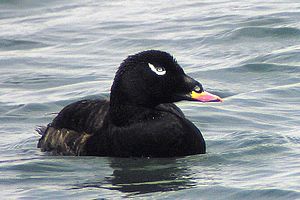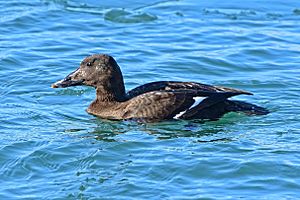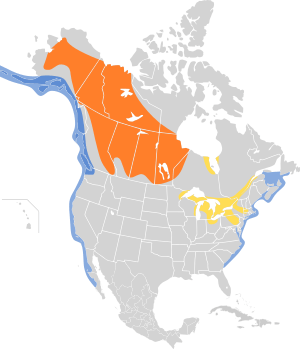White-winged scoter facts for kids
Quick facts for kids White-winged scoter |
|
|---|---|
 |
|
| Adult male of the American race deglandi | |
 |
|
| Female, Toronto | |
| Conservation status | |
| Scientific classification | |
| Genus: |
Melanitta
|
| Species: |
deglandi
|
 |
|
| Synonyms | |
|
Melanitta fusca deglandi |
|
The white-winged scoter is a large sea duck. Its scientific name is Melanitta deglandi. The name Melanitta comes from old Greek words meaning "black duck." The second part, deglandi, honors a French bird expert named Côme Damien Degland.
Contents
About the White-winged Scoter
The white-winged scoter is the biggest type of scoter found in North America. It has a chunky body and a large bill.
What They Look Like
Female white-winged scoters are brown. They have lighter patches on their heads. They usually weigh about 1.2 kilograms (2.6 pounds). They are about 52 centimeters (20.5 inches) long.
Male white-winged scoters are mostly black. They have a white patch around their eye. They also have a white patch on their wing, called a speculum. This white patch is usually hidden when their wings are folded. Males typically weigh about 1.4 kilograms (3 pounds). They are about 55 centimeters (21.5 inches) long. Their wings can spread up to 80 centimeters (31.5 inches) wide.
The bill of a white-winged scoter has a black base. It also has a noticeable bump, or "knob," on it.
White-winged vs. Stejneger's Scoter
There is another similar bird called the Stejneger's scoter. Male white-winged scoters have browner sides. Their bills are mostly dark yellow with a smaller knob. Stejneger's scoters have a very tall knob on their mostly orange-yellow bill. Female birds of both species look very much alike.
Where White-winged Scoters Live
White-winged scoters breed in the far northern parts of North America. When winter comes, they fly south. They spend winter in warmer areas. You can find them on the Great Lakes and along the coasts of the northern United States. They also stay on the southern coasts of Canada.
These ducks often gather in large groups on coastal waters. They fly together in tight flocks. Sometimes, they visit Europe by accident. They have been seen in places like Scotland, Iceland, Norway, and Ireland.
White-winged Scoter Behavior
Reproduction and Life Cycle
White-winged scoters build their nests on the ground. They like to be near the sea, lakes, or rivers. Their nests are often in woodlands or open tundra areas. A female usually lays 5 to 11 eggs. The eggs are pinkish and weigh about 82 grams (2.9 ounces).
The mother duck sits on the eggs for about 25 to 30 days. After the ducklings hatch, female ducks sometimes get aggressive with other nesting females. This can cause confusion, and broods of ducklings might mix together. A mother duck might end up taking care of as many as 40 young!
The female will look after her ducklings for about three weeks. After that, she leaves them. However, the young ducks usually stay together for another three weeks. Young scoters can typically start flying when they are 63 to 77 days old.
What White-winged Scoters Eat
White-winged scoters eat different things depending on where they are.
- In freshwater, they mainly eat crustaceans (like tiny shrimp) and insects.
- In saltwater, they prefer molluscs (like clams) and crustaceans.
Some of their favorite foods include a small freshwater creature called Hyalella azteca. In saltwater, they love rock clams (Protothaca staminea), Atlantic razor clams (Siliqua species), and Arctic wedge clams (Mesodesma arctatus).
See also
 In Spanish: Negrón aliblanco para niños
In Spanish: Negrón aliblanco para niños



